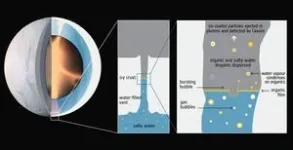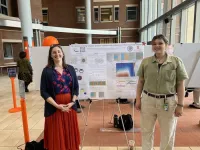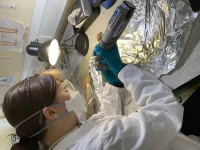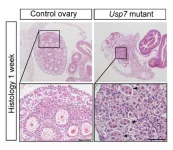(Press-News.org) Of all the carbon stored in ecosystems around the world, about half can be found in soils. Depending on climate, vegetation, and management, soils can be either a carbon source or a sink.
Natural climate solutions (NCS) offer a promising opportunity to bring us closer to our net-zero emissions goals by removing carbon dioxide from the atmosphere and storing it in plant biomass and soil. The growth of bioenergy feedstocks has great potential in this regard, because these grasses both build soil carbon and have the potential to be used to produce carbon-neutral biofuels and bioproducts.
Over the last 40 years, biogeochemical models have been a crucial tool that researchers use to understand how climate, ecological disturbance, and land management affect carbon and other fluxes in an ecosystem. Due to their success, biogeochemical models are gaining traction as important tools to evaluate the efficacy of NCS. These models can be used to inform management and policy decisions.
One of these models, called DayCent, simulates daily fluxes of carbon, nitrogen, and water between the atmosphere, vegetation, and soil. However, projecting the potential of large perennial bioenergy crops as NCS was challenging due to two limitations of previous versions of the DayCent model. Like many ecosystem models, DayCent did not explicitly model soil microbes and the role they play as drivers of soil carbon cycling. Additionally, large perennial grasses like miscanthus and switchgrass have distinct physiological traits that are not accounted for in many model frameworks.
To remedy this issue, a CABBI research team in the Sustainability Theme has developed DayCent-CABBI, a model that integrates soil microbes and the distinct physiological traits of large perennial grasses into DayCent.
In a new paper published in Geoderma, the researchers discuss the development and validation of DayCent-CABBI — and put its predictive power to the test.
“Adding new plant and microbe components to the DayCent-CABBI model improves its representation of ecosystem dynamics,” said Melannie Hartman, a lead author on the study and Senior Research Associate at Colorado State University. “These advancements enhance the model’s ability to evaluate the sustainability of growing different types of bioenergy crops.”
Microbes in the soil contribute to significant carbon storage and fluxes, so the research team updated DayCent to include a live microbial biomass pool. This feature regulates the release of carbon dioxide to the atmosphere based on its pool size. They also added a dead microbial biomass pool that allows for a more realistic representation for carbon to flow from one pool to another, which will better simulate carbon storage in soil.
“Microbes are important to include in the model because, for example, dead microbial biomass carbon is more likely to be retained in the soil system for decades to millennia if it has a strong bond to soil mineral surfaces,” said Danielle Berardi, lead author and recent graduate with an Ecology Ph.D. from the University of Idaho. “The maximum capacity of this type of soil carbon in a given system is based on the soil texture, which determines the available surface area for carbon to bond to. We have improved how mineral associated organic matter is represented in DayCent, which is crucial for modeling measurable soil organic matter pools.”
The other significant change the team made focused on more accurately modeling different parts of perennial plants. Traditional models have lumped together leaves and stems as “aboveground plant components.” Splitting up these plant parts and modeling them separately allows DayCent-CABBI to more accurately simulate carbon, nitrogen, and lignin content for each, both improving how plant growth is simulated as well as providing more realistic litter chemistry and more versatile harvest options with implications for soil carbon and nitrogen cycling. In addition, the team added a rhizome component to the model. Rhizomes are shallow perennial roots that store carbohydrates and nitrogen during the dormant season when aboveground plant parts have withered. Because these root systems in bioenergy crops like miscanthus aren’t adapted for harsh winters that they may face in the central U.S., the researchers added a temperature threshold for the rhizomes – once temperatures drop far enough, the model will simulate damage to the rhizomes.
With these modifications, the researchers put DayCent-CABBI to the test by simulating switchgrass and miscanthus at the University of Illinois Energy Farm from 2008 to 2049. The model was calibrated and evaluated using field data from 2008 to 2019. When compared to historical data, the version of the model with the new microbial-explicit soil model had better model-data agreement with daily ecosystem carbon fluxes, particularly in the springtime, indicating that this modification does indeed improve DayCent’s ability to accurately assess the potential of perennial grasses as NCS.
Under future simulations (2020-2049), the version of DayCent using the previous soil model simulated continually increasing soil carbon into the future for both crops, whereas the new version simulated an eventual plateau of soil carbon before 2049. This plateau represents the researchers’ best understanding of future soil carbon fluxes and stabilization in miscanthus and switchgrass.
“These much-needed modeling advances benefit not only CABBI but also the greater community of researchers and stakeholders who want to estimate the carbon intensity of growing high-yielding perennial grasses for biofuel and bioproduct production,” said co-author Wendy Yang, CABBI’s Sustainability Theme Leader and a Professor of Plant Biology at the University of Illinois Urbana-Champaign.
Co-authors on this study include West Virginia University Associate Professor of Forest Ecology and Ecosystem Modeling Edward Brzostek; University of Idaho Associate Professor of Forest, Rangeland and Fire Sciences Tara Hudiburg; Colorado State University Senior Research Scientist William Parton; USDA ARS Research Plant Physiologist Carl Bernacchi; University of Illinois Professor Emeritus of Plant Biology Evan H. DeLucia; Illinois Postdoc Adam von Haden; Illinois Postdoc Ilsa Kantola; and University of Western Australia School of Agriculture and Environment lecturer Caitlin Moore.
— Article by CABBI Communications Specialist April Wendling and Communications Intern Anjali Yedavalli
END
DayCent-CABBI: new model integrates soil microbes, large perennial grasses
Team has developed and validated a new, improved model that evaluates the sustainability of bioenergy crops.
2024-03-22
ELSE PRESS RELEASES FROM THIS DATE:
Maple syrup producers provide sweet news for threatened birds
2024-03-22
The summer mating season is looking to get a lot easier for the scarlet tanager, one of a number of migratory songbirds that use the forests of northeastern North America to find a mate.
In recent decades, the loss and degradation of bird habitats has led to a precipitous decline in bird populations. Now, a $2 million grant awarded to the National Audubon Society’s Bird-Friendly Maple program, in partnership with College of Natural Resources and Environment Associate Professor Ashley Dayer, will look to improve bird habitats by encouraging maple syrup producers to incorporate forest management practices that allow other ...
Neighborhood-level poverty and food insecurity during pregnancy associated with lower birthweight and small for gestational age infants, NIH study finds
2024-03-22
Living in neighborhoods where residents have lower incomes and limited food access during pregnancy was associated with an increased risk of babies born small for gestational age or with lower birthweight, according to a new study from the NIH Environmental Influences on Child Health Outcomes (ECHO) Program.
Previous studies have shown that maternal diet during pregnancy can impact the physical and mental health of a mother. However, less is known about how food insecurity affects health outcomes for newborns. In a new research article, ECHO researchers analyzed data to understand what connections might exist between where a pregnant ...
Using physics principles to understand how cells self-sort in development
2024-03-22
Erin McCarthy ’23, physics summa cum laude, is a rarity among young scientists. As an undergraduate researcher in Syracuse University's College of Arts & Sciences’ Department of Physics, she guided a study that appeared in March 2024 in Physical Review Letters. It is the most-cited physics letters journal and the eighth-most cited journal in science overall.
McCarthy and postdoctoral associates Raj Kumar Manna and Ojan Damavandi developed a model that identified an unexpected collective ...
SFU Publishing Director Hannah McGregor's new book asks "Can podcasting save academia?"
2024-03-22
A new book from Lori Beckstead, Ian M. Cook, and SFU Publishing Director Hannah McGregor, explores how the growth of scholarly podcasting may engender radical possibilities for how we conceive of knowledge creation and peer review, and the transformative potential of new modes of creating and reviewing expert knowledge.
"Podcast Or Perish" investigates the historical development of the norms of scholarly communication and asks how podcasting might change how we think about scholarly work. Could this be the call to action academia needs?
Read ...
Early intervention after the first seizure may prevent long-term epilepsy and associated cognitive deficits
2024-03-22
PHILADELPHIA— Only a very small percentage of neurons show changes after an epileptic seizure in mice, but these alterations can be permanent and trigger future seizures that can affect the whole brain and lead to impaired cognition, like memory and learning, according to new research from the Perelman School of Medicine at the University of Pennsylvania. The researchers identified an experimental treatment that, if provided within the first 48 hours after the first seizure, can prevent these long-term changes. The findings, which were published recently in The ...
Key appointments to advance technology, entrepreneurship and innovation at the University of Houston
2024-03-22
The University of Houston is proud to announce the appointment of two distinguished professionals to key leadership roles within the Office of Technology, Transfer, and Innovation (OTTI) under the Division of Energy and Innovation. These appointments mark a significant step forward in the University's continued commitment to fostering entrepreneurship, innovation and partnerships between academia and industry.
Haleh Ardebili, the Kamel Salama Endowed Professor of Mechanical Engineering, has been appointed as the new assistant vice president of Entrepreneurship and Startup Ecosystem. Michael Harold, ...
Signs of life detectable in single ice grain emitted from extraterrestrial moons
2024-03-22
The ice-encrusted oceans of some of the moons orbiting Saturn and Jupiter are leading candidates in the search for extraterrestrial life. A new lab-based study led by the University of Washington in Seattle and the Freie Universität Berlin shows that individual ice grains ejected from these planetary bodies may contain enough material for instruments headed there in the fall to detect signs of life, if such life exists.
“For the first time we have shown that even a tiny fraction of cellular material could be identified by a mass spectrometer onboard a spacecraft,” said lead author Fabian Klenner, a UW postdoctoral researcher in Earth and space sciences. ...
Tudor era horse cemetery in Westminster revealed as likely resting place for elite imported animals
2024-03-22
Archaeological analysis of a near unique animal cemetery discovered in London nearly 30 years ago has revealed the international scale of horse trading by the elites of late medieval and Tudor England.
Using advanced archaeological science techniques, including studying chemical composition, researchers have been able to identify the likely origins of several physically elite horses and the routes they took to reach British shores during the formative years of their life.
These animals – akin to modern supercars – were sourced from a variety of locations across ...
Researchers uncover protein interactions controlling fertility in female mice
2024-03-22
Francis Crick Institute press release
Under strict embargo: 18:00hrs GMT Friday 22 March 2024
Peer reviewed
Experimental study
Animals
Researchers uncover protein interactions controlling fertility in female mice
Researchers at the Francis Crick Institute have shed light on the proteins controlling the development of ovaries in mice before and after birth. This could lead to a better understanding of how female infertility develops.
Following their research identifying the gene responsible for initiating the development ...
Scientists explore complex pattern of tipping points in the Atlantic’s current system
2024-03-22
An international team of scientists have warned against relying on nature providing straightforward ‘early warning’ indicators of a climate disaster, as new mathematical modelling shows new fascinating aspects of the complexity of the dynamics of climate.
It suggests that the climate system could be more unpredictable than previously thought.
By modelling the Atlantic meridional overturning circulation, one of the main ocean current systems, the team which included mathematicians from the University of Leicester have found that the stability of ...
LAST 30 PRESS RELEASES:
World-first discovery uncovers how glioblastoma tumours dodge chemotherapy, potentially opening the door to new treatments
A fatal mix-up: How certain gut bacteria drive multiple sclerosis
New AI tool identifies not just genetic mutations, but the diseases they may cause
Deep-learning model predicts how fruit flies form, cell by cell
Combination pills for high blood pressure may simplify treatment, improve long-term health
Immune system keeps mucosal fungi in check
Neurons within the brain use simple rules to localize genetic messages
Electrodes created using light
Second-hand gift-giving is a well-deliberated decision
How human interaction drove evolution to make bears less aggressive
National Poll: Few parents offer teens guidance on healthy eating during holiday season
Cannabis derivatives could provide new ovarian cancer treatments
Raising strong yeast as a petroleum substitute
Clues to the origin of hot Jupiters hidden in their orbits
Canada’s reduced pledge to Global Fund will impact domestic health
1 in 4 children with major traumatic injuries not cared for in pediatric trauma centres
Duke and Duke-NUS’ joint cross-population research to uncover "East-West" differences in disease and care
Scientists to ‘spy’ on cancer- immune cell interactions using quantum technology breakthrough
Tech savvy users have most digital concerns
Making lighter work of calculating fluid and heat flow
Normalizing blood sugar can halve heart attack risk
Lowering blood sugar cuts heart attack risk in people with prediabetes
Study links genetic variants to risk of blinding eye disease in premature infants
Non-opioid ‘pain sponge’ therapy halts cartilage degeneration and relieves chronic pain
AI can pick up cultural values by mimicking how kids learn
China’s ecological redlines offer fast track to 30 x 30 global conservation goal
Invisible indoor threats: emerging household contaminants and their growing risks to human health
Adding antibody treatment to chemo boosts outcomes for children with rare cancer
Germline pathogenic variants among women without a history of breast cancer
Tanning beds triple melanoma risk, potentially causing broad DNA damage
[Press-News.org] DayCent-CABBI: new model integrates soil microbes, large perennial grassesTeam has developed and validated a new, improved model that evaluates the sustainability of bioenergy crops.










